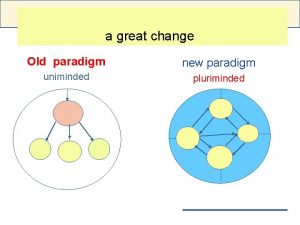Lecture 6 More DivideConquer and Paradigm 4 Data









- Slides: 9

Lecture 6 More Divide-Conquer and Paradigm #4 Data Structure. n Today, we do more “divide-and-conquer”. n And, we do Algorithm design paradigm # 4: invent or augment a data structure.

More divide and conquer: powering a number n Problem: Compute an , where n is an integer. n Naïve algorithm Θ(n). n Divide-and-conquer: an = an/2 = a(n-1)/2 a if n is even. if n is odd Note, another kind of divide and conquer. Time complexity: T(n) = T(n/2) + Θ(1) = Θ(logn)

Back to Fibonacci numbers n Recursion: not careful would give exponential time algorithm. n Plain linear bottom up computation: Θ(n). n Can we do better? n Theorem: Fn+1 Fn 1 1 Fn Fn-1 1 0 I will prove this in class. Then you can compute this similar to powering of an integer in Θ(logn) steps.

VLSI tree layout n Problem: Embed a complete binary tree with n leaves in a grid using minimal area. W(n) H(n) = Θ(lg n) Area = Θ(n lg n) W(n) = Θ(n)

How do we improve this embedding? n If we wish to have an O(n) solution for the area, perhaps we wish to have √n for L(n) and W(n). n What recursion scheme would get us there? n The Master theorem Case 1 says if b=4, a=2, then log 4 2 =1/2. So if we have something like T(n) = 2 T(n/4) + o(√n) we would get O(√n) solution for L(n) and W(n).

H-tree embedding scheme L(n/4) L(n) = 2 L(n/4) + Θ(1) = Θ(√n) Area = Θ(n)

Paradigm #4 Use a data structure.

Example 1. Heapsort n We invent a data structure (the heap) to support sorting.

Example 2. Subrange sum n We want to maintain an array of integers a[1. . n], and support the following operations: A. Increment a[i] by b; that is, set a[i] += b. n B. Subrange sum: compute the sum of the elements a[c], a[c+1], . . . , a[d]. n n Augment array as follows: a[1] a[2] a[3] a[4] a[5] a[6] a[7] a[8] a[1. . 2] a[3. . 4] a[5. . 6] a[7. . 8] a[1. . 4] a[5. . 8] a[1. . 8] n Operations A and B are both in O(logn) time.
 More more more i want more more more more we praise you
More more more i want more more more more we praise you More more more i want more more more more we praise you
More more more i want more more more more we praise you Old paradigm
Old paradigm 01:640:244 lecture notes - lecture 15: plat, idah, farad
01:640:244 lecture notes - lecture 15: plat, idah, farad Human history becomes more and more a race
Human history becomes more and more a race 5 apples in a basket riddle
5 apples in a basket riddle The more you study the more you learn
The more you study the more you learn Aspire not to have more but to be more
Aspire not to have more but to be more Newton first law examples
Newton first law examples Knowing more remembering more
Knowing more remembering more















